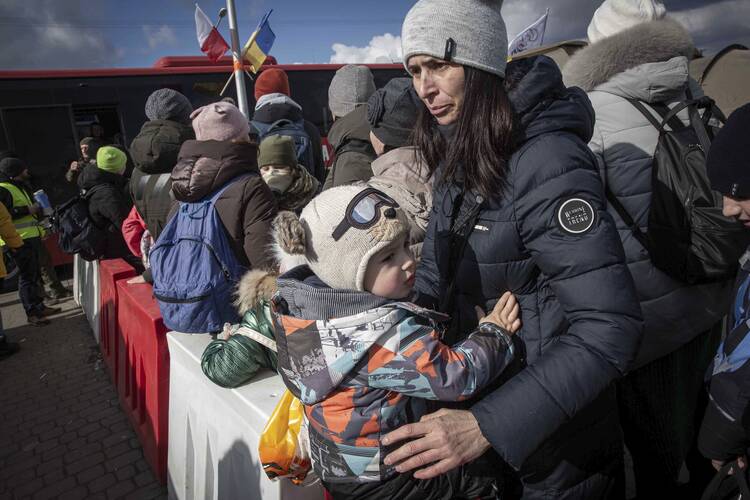Russia’s horrific invasion of Ukraine has so far forced some two million people, including one million children, to flee the country, with many others internally displaced within Ukraine. The numbers could be far larger than those of the 2015 refugee crisis, during which families fleeing Syria’s civil war set out for Hungary and other European nations. But in the current rush to help refugees, countries should learn from past responses. Most of all, this is a chance for the Catholic Church in Hungary, whose government has loudly opposed accepting refugees in the past, to correct its mixed record on fighting xenophobia.
This is a chance for the Catholic Church in Hungary, whose government has loudly opposed accepting refugees in the past, to correct its mixed record on fighting xenophobia.
In 2015, images of exhausted refugees locked out of Budapest’s downtown train station rocketed around the world. The Budapest city government claimed it was following European Union law by preventing the refugees from traveling on to Germany, where they hoped to apply for asylum. However, the repeated fearmongering by Hungarian Prime Minister Viktor Orbán, who claimed that Germany’s liberal stance on accepting refugees caused the crisis, made it clear that the harsh treatment in Budapest was meant as a signal that the refugees were not welcome in Europe. Consequently, many heard Pope Francis’ words about embracing diversity during his visit to Budapest last year as a veiled criticism of Hungary’s government for not doing more to welcome the poor and marginalized. Yet nearly every Hungarian bishop stayed silent about the government’s decision to erect an anti-migrant barbed-wire fence on its border with Serbia.
There are reports of ordinary Hungarian citizens driving to the Ukrainian border with food, but Aiski Ryökäs of the Migrant Solidarity Group of Hungary is urging people not to go into the crisis areas: “Professionals on the ground know what people need and they can provide for those in need quickly from local sources.” Humanitarian aid professionals who were on the ground in 2015 are also warning about a repeat of the chaos that ensued when well-meaning activists from neighboring countries ended up getting in the way of an effective response in Hungary. (For one thing, they may take up space in hotels, dormitories and private homes that could accommodate refugees.) Donations to the Catholic Church’s Caritas-Hungary, which is coordinating with Caritas-Ukraine, will provide aid to families at the border, many of whom are waiting a day or more to cross.
Many heard Pope Francis’ words about embracing diversity during his visit to Budapest last year as a veiled criticism of Hungary’s government for not doing more to welcome the poor and marginalized.
The Hungarian government now declares a commitment to European and Catholic values on accepting refugees, which has led Filippo Grandi, the United Nations high commissioner for refugees, to express hope there will be a broader, long-lasting change in the treatment of displaced persons. But we should not be too quick to trust that things have changed: Even reports about the refugee crisis can reflect a political agenda. Hungary’s right-wing government has spent a decade buying up media outlets and forcing them to repeat its messaging, and in the current crisis it has launched a new strategy to burnish its image in the Western media.
Alex Faludy, an independent Hungarian journalist, told me that the Hungarian government has invited freelance and staff journalists with regular bylines in British outlets like The Spectator and the online magazine UnHerd to one-on-one meetings with high-level Hungarian officials. Efforts to woo opinion makers in Western Europe are already showing fruits inflattering coverage about Hungary’s refugee aid and commitment to NATO. But Zalán Zubor, a journalist writing for the independent news site Átlátszó, revealed that the official Hungarian media continues to pump out articles falsely callingUkraine “an aggressor” and even calling for “Hungary to support the division of Ukraine.”
The international community should make sure the Hungarian government continues to provide aid to all refugees, regardless of ethnicity or religious background.
Alexis Okeowo, writing in The New Yorker, also pointed out the hypocrisy in Hungary’s quickness to welcome refugees from a country perceived to be white and Christian and asked, “will the war in Ukraine mean anything for Europe’s other refugee crisis—for the refugees who are not white, possibly not Christian, but who are also in need?” But those fleeing the fighting are hardly a monolith. Ukraine’s Roma minority, for example, are also being displaced into countries where Roma have often suffered racial discrimination.
So even as the Hungarian government is providing much-needed aid, the real test will be in the weeks and months to come. If the conflict stretches on and refugees apply for asylum in the countries where they have been living (as required by E.U. law), the international community should make sure the Hungarian government continues to provide aid, including administrative support for asylum applications, to all refugees, regardless of ethnicity or religious background.
This also means Hungary should provide for Roma refugees’ material well-being, as well as their basic right to religious and cultural recognition while they are living in the country. Catholics can hold the Hungarian church accountable for the promises it made to translate the Mass into the Roma language and minister to the needs of the Roma community, especially after Pope Francis’ groundbreaking 2019 call to action to fight racism against that community.
The world is discovering that Ukraine reflects the entire Eastern European region in its ethnic and religious diversity, including a large international population. Catholics should follow Pope Francis’ example in urging the Catholic Church in the region to do everything it can to celebrate diversity and foster acceptance.
[Read next: American hearts bleed for Ukrainians. But Latin Americans? Meh.]








